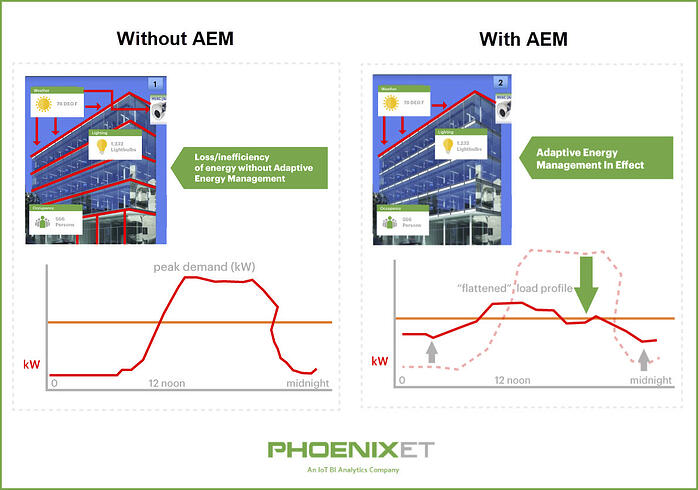Share this
Demand Response and Peak Strategies for Facility and Energy Managers
by Phoenix Energy Technologies on Aug 10, 2021

Although “load shedding”--or the practice of taking customers offline through rotating outages--served as a short-term solution during Winter Storm Uri earlier this year, planning for demand management requires a long view that anticipates crises, prevents outages, and integrates traditional and distributed generation resources.
How Does Peak Demand Impact Costs
All loads connected to a power system create a combined or aggregate demand. Because load requirements vary according to equipment and need, demand usage may change during each day or during periods of time. The power system design includes the generation capacity needed to meet increases in electric use called peak demand. Any increase in peak demand requires either an increase in the power supply or a decrease in load.
Large companies and individual consumers pay rates based on demand. Electricity used during on-peak periods has a higher cost than electricity used during semi-peak or off-peak periods. Businesses with multiple locations often have seasonal load profiles that often result in hefty peak demand charges. When considering a typical monthly energy bill, peak demand costs may increase by as much as 70%, with the remainder allocated for basic charges.
As a result, electric utilities and businesses seek methods for managing load and reducing energy requirements. From a utility perspective, peak shaving decreases the operational cost of generating electricity during high-demand periods. An electric utility can avoid purchasing energy from high-cost market sources. System reliability improves through the capability to reduce peak loads and balance power demand.
Peak Shaving and Demand Response Offer Significant Benefits
Peak shaving involves controlling energy use during maximum demand periods through two basic options. Reducing the electrical load eliminates short-term demand spikes. Utilities may also supplement traditional generation resources with distributed generation, including wind and solar, to accomplish peak shaving. Both options smooth the peak load and decrease demand charges.
Demand response accomplishes peak shaving through the management of consumption. Demand response establishes a temporary method for decreasing kilowatts of demand during peak usage hours or during times when transmission and distribution congestion can cause an imbalance for facility and energy managers.
In brief, demand response programs--and the software associated with those programs--keeps the lights on. Energy managers gain additional benefits by consistently monitoring energy data and discovering opportunities to reduce consumption and cost.
Utility Agreements
A demand response program begins with commitment. Utilities contractually commit to either paying customers or designing special rate packages for their commitment to reducing non-essential load during critical events that create peak demand. Customers receive the benefit of a revenue stream or reduced rates while decreasing their electricity use.
With the load reduced, utilities benefit by having a balanced and reliable grid. In turn, market prices for electricity remain lower because of the reduced demand. Demand response also adds peak capacity to the market. As a result, the market can avoid sudden and dramatic cost increases for fuels. Flattening price peaks reduces volatility and risk while also allowing cost savings.
Advanced Technologies for Peak Shaving and Demand Response
Changing energy consumption patterns for multi-location business units requires a management approach that reduces demand and yields permanent cost savings while also defining short-term solutions for peak load periods.
Dynamic Energy Management
Dynamic energy management may enhance grid stability and solve peak demand problems. Adding solar panels or wind generation to a facility provides a long-term option for generating power and reducing reliance on the grid during peak demand hours. Coupling alternative energy with behind-the-meter battery storage allows facilities to charge batteries with either energy from the grid or solar panels. A dynamic energy management system seamlessly moves energy use from the grid to battery storage.
Building management systems can take advantage of the data obtained through smart appliances connected to utilities through sensors, embedded software, and the Internet of Things (IoT) to track and accomplish peak shaving.
For example, energy managers can combine the data obtained from smart systems with other data that shows the best times to schedule multiple cooling units to run during off-peak hours. Energy managers can optimize systems to ensure that the appropriate indoor temperatures exist while distributing energy use over time. Dynamic energy management at the facility level may also factor the impact of weather conditions on an HVAC system as a method for lowering peak demand.
DERs
Aggregating bundles of distributed energy resources (DERs) to obtain predictability on the grid requires hardware devices for connecting resources and software that predicts outages, forecasts electricity demand, and shows the impact of DERs at peak demand times.
In much the same way, achieving and maintaining a demand response program requires software and equipment that continuously and consistently moves and analyzes real-time data between power sources and different types of facilities. End-to-end automated communication and metering technologies rely on sensors, telemetry, and advanced analytics to monitor grid stability and reduce demand by comparing the need to reduce load with a customer’s baseline load profile.
Comparing the amount of a load used with the expected amount of load across multiple locations adds complexity to demand response programs. Answering this challenge requires systems based on flexible rules, remote command functionality, and easy-to-interpret reporting capabilities. Sophisticated demand response systems used for multi-location businesses constantly monitor and manage facility environmental conditions at the zone and sub-system level without impacting staff or customer satisfaction.
Pulling Down Energy Costs and Usage
Another strategy facility and energy managers can use to bring down power costs, and usage is through adaptive energy management (AEM). AEM combines technology, building profiles, and the science of temperature and energy to achieve energy goals.
AEM enables managers to reduce energy loads and shift those loads off-peak while enhancing staff and customer comfort. Check out our guide Adaptive Energy Management - How to Use Your Buildings as a Battery to learn the basics of how buildings are engineered for temperature—and how adaptive energy management applications can control energy better.
Additional Resources
What Facility Managers Need to Know About Load Shifting - Part 1
Are You Managing Your Energy Spend?
Precision Building Management: Understanding Closed Loop Control
Share this
- Facilities Management (91)
- Energy Management (69)
- Company News (49)
- Smart Buildings (37)
- Retail (36)
- Building Management (24)
- Building Automation Systems (21)
- Sustainability (20)
- Energy Demand Management (19)
- EEI (15)
- Adaptive Energy Management (14)
- Grocery (14)
- demand response (14)
- Artificial Intelligence (12)
- Data Integration and Visibility (10)
- HVAC IQ (9)
- COVID-19 (8)
- Customer Spotlight (8)
- Carbon Management (7)
- Setpoints and Temperatures (7)
- Equipment Maintenance (6)
- Operational Efficiency (6)
- Refrigeration Optimization (6)
- Ask Ron (5)
- Asset Manager (5)
- Finance and Procurement (5)
- IoT and Digital Transformation (5)
- Awards (4)
- Comfort (4)
- Energy & Store Development (4)
- Safety and Compliance (4)
- Demand Charge Management (3)
- Energy Management System (3)
- Lifecycle Asset Management (3)
- Premium Services (3)
- Refrigeration IQ (3)
- Automated Demand Response (2)
- ConnexFM (2)
- Customer Service (2)
- HVAC Vendor Management (2)
- Load Shedding (2)
- Technician View (2)
- AIM Act (1)
- ALD (1)
- Analytics (1)
- Data (1)
- Data Integration and Visualization (1)
- EMS (1)
- Knowledge Center (1)
- OSHA (1)
- asset management (1)
- December 2025 (1)
- November 2025 (1)
- October 2025 (2)
- September 2025 (1)
- August 2025 (3)
- July 2025 (1)
- June 2025 (1)
- May 2025 (2)
- March 2025 (2)
- February 2025 (1)
- January 2025 (2)
- December 2024 (2)
- October 2024 (1)
- September 2024 (1)
- August 2024 (2)
- June 2024 (2)
- April 2024 (2)
- March 2024 (2)
- January 2024 (1)
- December 2023 (1)
- October 2023 (2)
- September 2023 (2)
- August 2023 (2)
- July 2023 (1)
- May 2023 (2)
- April 2023 (2)
- March 2023 (3)
- February 2023 (1)
- January 2023 (1)
- December 2022 (1)
- November 2022 (2)
- October 2022 (2)
- September 2022 (1)
- May 2022 (2)
- April 2022 (1)
- March 2022 (3)
- February 2022 (2)
- January 2022 (4)
- December 2021 (2)
- November 2021 (3)
- October 2021 (1)
- September 2021 (3)
- August 2021 (4)
- July 2021 (1)
- June 2021 (2)
- May 2021 (1)
- January 2021 (2)
- December 2020 (2)
- November 2020 (2)
- October 2020 (3)
- September 2020 (4)
- August 2020 (3)
- July 2020 (2)
- June 2020 (3)
- May 2020 (3)
- April 2020 (5)
- March 2020 (5)
- February 2020 (4)
- January 2020 (4)
- December 2019 (4)
- November 2019 (3)
- October 2019 (4)
- September 2019 (5)
- August 2019 (4)
- July 2019 (4)
- May 2019 (2)
- April 2019 (3)
- February 2019 (1)
- December 2018 (1)
- November 2018 (1)
- October 2018 (3)
- September 2018 (3)
- August 2018 (3)
- July 2018 (3)
- June 2018 (3)
- May 2018 (1)
- June 2015 (1)
- March 2013 (1)
- January 2013 (1)
- December 2011 (1)
- October 2011 (1)
- September 2011 (1)



